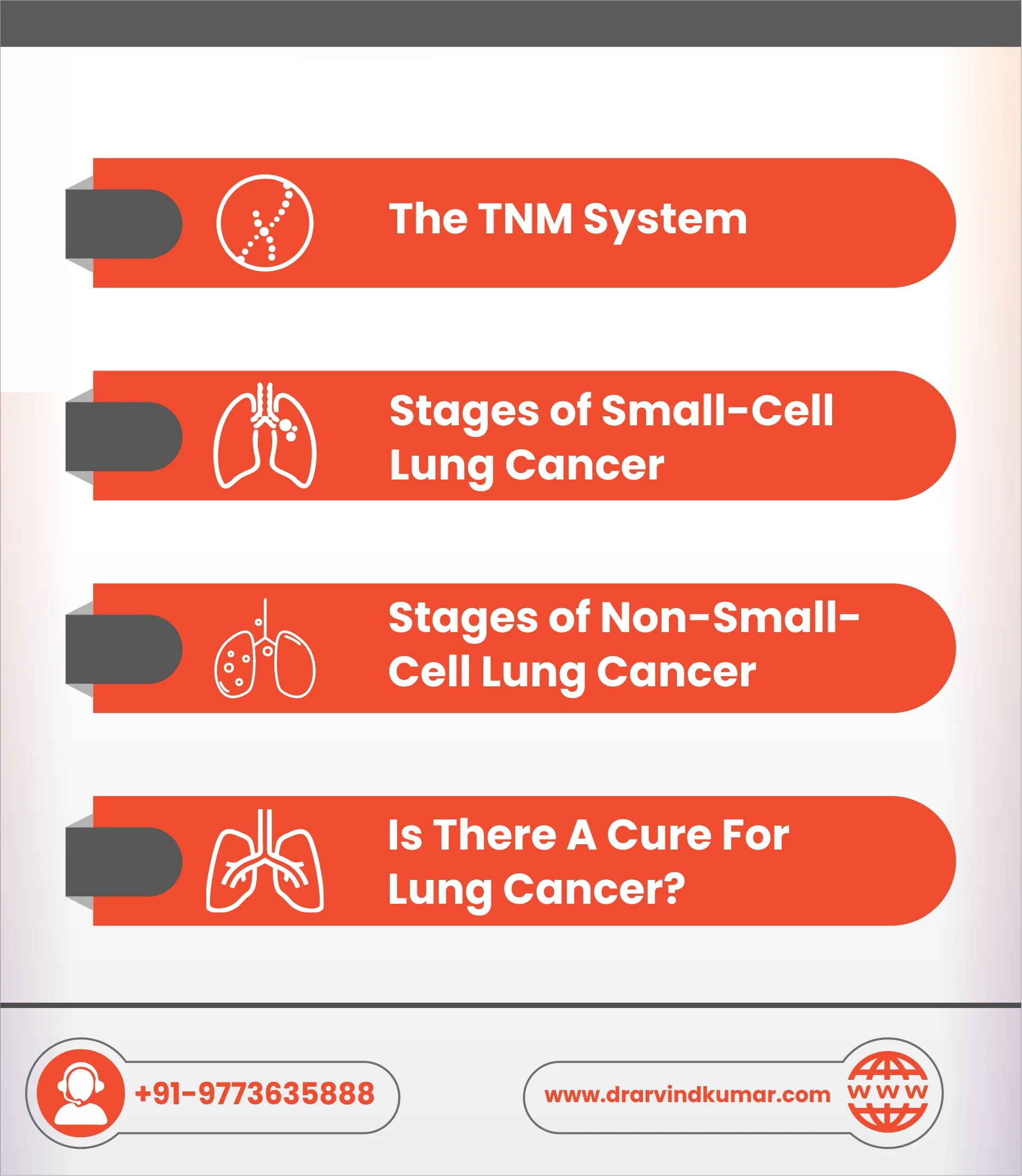Many cases of lung cancer can be cured with early detection and treatment. The cure rate is 80% to 90% if the disease is discovered early. However, when it comes to more advanced tumors, that rate lowers significantly, especially if cancer has spread to other parts of the body. Lets read to know more about the different stages of lung cancer, treating lung cancer, and can lung cancer be cured. How Many Stages of Lung Cancer Are There?
Before knowing how to cure lung cancer, Knowing your lung cancers stage is crucial because It reveals
- the location of any lung tumors or cancerous cells.
- the size of your tumor right now
- If your cancer has spread or is localized,
Small cell and non-small cell lung cancer are the two primary subtypes. Each has a unique staging.
Knowing the stage aids your doctor in deciding on the best course of treatment for you. They might use it to determine your chances of responding well to that treatment.
The stage of your lung cancer cannot be taken as a prediction of how long you will live.
The TNM System
The TNM (T – Tumor, N – Nodes & M – Metastasis) system uses the numerals X, 0, 1, 2, 3, or 4, following each letter, which is the most popular method for staging NSCLC tumors. The combination of letters and numbers will help your doctor stage your tumor, and the digits 0-4 will help them be more specific describe:
- Your tumors breadth, expressed in centimeters, or whether it is too small to measure at all, is indicated by a combination of numbers and letters.
- Where in your lung is the tumor located
- If the same lung contains many tumors
- If your airways are sufficiently congested or partially closed to result in pneumonia or a collapse of the lung
- If your lymph nodes or other organs have been affected by the tumor
Stages of Small-Cell Lung Cancer
Your doctor may employ the TNM system if you have this kind of cancer. Your cancer will then be classified as being in one of these two primary stages:
Limited stage– Only one lung and probably some adjacent lymph nodes are affected. It hasn gotten past your lungs or spread to both of them.
Extensive stage Your chest and lungs now contain further tumor growth. It might have spread to other organs, including your brain or the pleura, the fluid surrounding your lungs.
Stages of Non-Small-Cell Lung Cancer
Small cell lung cancer is less common than non-small cell lung cancer (NSCLC).
The pathologic or clinical stage of NSCLC is one approach to categorizing it. To determine the clinical stage of cancer, your doctor may utilize imaging scans to obtain images of the inside of your body. They might do a biopsy to look at a small sample of tumor tissue under a microscope to confirm the diagnosis.
Your doctor can examine your tumor and determine the pathological stage of your cancer if you have cancer surgery. Your doctor can determine from this how far the cancer has spread or progressed.
For NSCLC, doctors may also employ broad phases. You may stage your cancer in each of these ways using the TNM method and numbers:
Occult stage. Neither a biopsy nor imaging scans can reveal your tumor. Another name for it is concealed cancer.
Stage 0: Your tumor is quite small at stage 0. Your deeper lung tissues or the outside of your lungs are free of cancerous cells.
Stage I: Even though the lymph nodes are free of cancer, it has spread to lung tissues.
Stage II: Your lymph nodes close to your lungs may now be infected.
Stage III: characterized as the chest wall, its encompassing membrane, and the lymph nodes within the lung are affected by the cancer spreading.
Stage 3A: Only on the side of the chest where cancer first started to spread are lymph nodes discovered to be cancerous.
Stage 3B: Cancer has spread to the lymph nodes above the collarbone or on the other side of the chest.
Stage IV: a large area of your body is now where cancer has spread and grown in the spaces between your lungs. Cancer has metastasized to your bones, liver, and your brain.

Is There A Cure For Lung Cancer?
Is there a cure for lung cancer or not depends on finding cancer when it is still in its earliest stages. As it is then, when the cancer is most responsive to treatment, it is critical for surviving it, as it is with several other cancers. The cure rate for people with tiny, early-stage lung cancer can reach 80% to 90%. The answer to – lung cancer can be cured at stage 4, can be disheartening to hear owing to the advanced spread of malignancy at this stage.
As the tumor becomes more advanced and includes lymph nodes or other body parts, the likelihood of recovery substantially decreases. How well a person responds to lung cancer treatment depends on factors such as age and general health.
Is stage 1 lung cancer curable?
Stage 1 lung cancer typically has no visible symptoms. Only 12% to 15% of NSCLCs are discovered when they are still at this stage as result. The prognosis is excellent because it is the most recent stage of the disease and with early intervention, which is nearly always surgery to remove the tumor, stage 1 lung cancer is frequently curable.
Is stage 2 lung cancer curable?
Stage II (2) lung cancer is a form of illness that is still in its early stages and may be treated surgically or in combination with other therapies like chemotherapy and radiation.
Even while some stage II tumors have spread to neighboring lymph nodes, they haven yet affected distant organs or bones. Your cancer may be localized or regional, depending on the size of your tumor and the location of any afflicted lymph nodes. Surgery followed by chemotherapy is frequently used by doctors to remove stage II cancer.
Is Stage 3 lung cancer curable?
Stage 3 lung cancer is incredibly difficult for doctors to treat. This is because cancer has already spread by the time a person experiences symptoms. Getting an earlier diagnosis is one method to solve this. Stage 3 lung cancers are now incurable, however, treatment can frequently help extend life and ease symptoms. A stage 3 lung cancer patient may occasionally live for an additional five years or more.
Its crucial to remember that stage 3 lung cancer may be incurable; however, it is treatable. Since every person is unique, it is impossible to accurately predict how a person will react to treatment.
Is stage 4 lung cancer curable?
The most advanced stage of this illness is stage 4 non-small cell lung cancer (NSCLC), also known as metastatic lung cancer. It describes any NSCLC of any size or kind that has metastasized to another part of the body, the fluid surrounding the lung or heart, or from one lung to the other. Stage 4 NSCLC is regarded as inoperable because it has spread outside the lungs. Although stage 4 NSCLC cannot be cured, it can be treated and managed. People can now manage this disease and live longer, more fulfilling lives thanks to new drugs. Lung Cancer Stages
Conclusion
Lung cancer is usually most treatable when it is discovered in a still early stage. Unfortunately, lung cancer symptoms are not usually present in their early stages.
In any stage of lung cancer, some factors can prolong or shorten life. Knowing what they are and altering anything that are changeable can improve your chances of remission and contribute to living the longest, healthiest life possible. The sort of cancer you have and the stage at which you are diagnosed will determine how it is treated. Radiation, chemotherapy, and surgery are frequently used as treatments. Patients with lung cancer are benefiting from newer medicines that are increasing their chances of survival, and taking part in a research study may hold promise when previous treatments aren working.
FAQs
Is lung cancer a malignancy that spreads quickly?
The type of lung cancer tumor affects the rate of cancer growth. Small cell lung carcinoma is regarded as a cancer form with rapid growth. Compared to small cell lung cancer, non-small cell lung cancer is more prevalent and spreads more slowly.
How is the detection of lung cancer done in its early stages?
Although lung cancer is typically detected at later stages of the disease, screenings can detect it early in some high-risk populations. Anyone between the ages of 50 and 80 who smokes or has quit within the previous 15 years and has a 20-pack-year smoking history is advised to get screened for lung cancer.

.webp)



